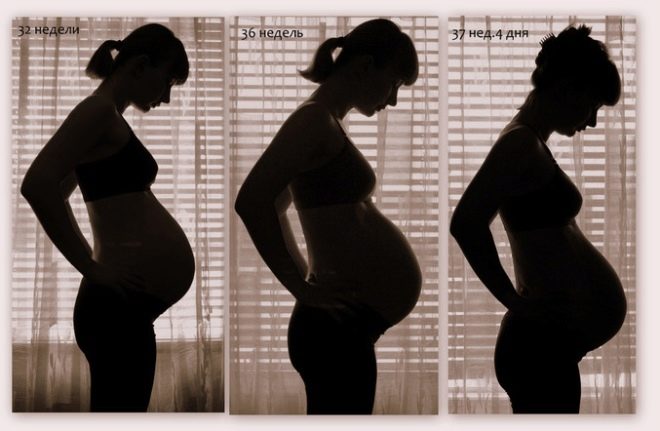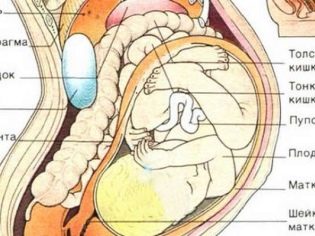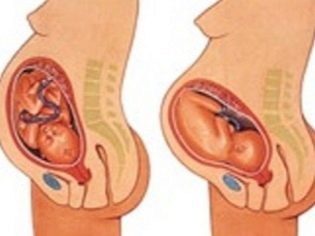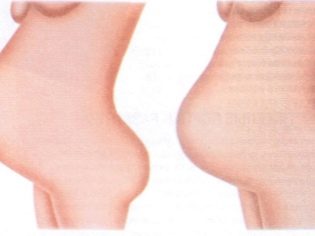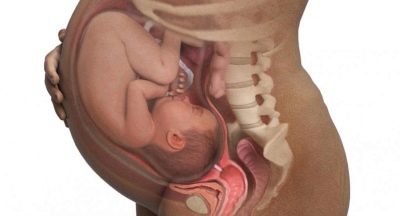How many days before the birth does the belly usually go down and what does it depend on?
The omission of the abdomen during pregnancy by expectant mothers is rightly regarded as the first sign of an imminent approaching birth. But not all women, especially primiparous, are confident that they can unmistakably recognize the moment of abdominal prolapse.
In this article, we will talk about how long before the birth we should expect abdominal prolapse and why this happens.
Mechanism of omission
The uterus is a very elastic organ, for pregnancy it increases in size almost 500 times. It is these growth rates that are physiologically able to provide sufficient space inside the body, which is necessary for the growth and development of the baby.
A large uterus with a baby inside, almost a pound of placenta and a fetal bladder filled with amniotic fluid, noticeably “infringes upon the rights” of neighboring organs, which every day due to an increase in the size of the baby, the uterus, there is less and less available space in the abdominal cavity.
Unlike the reproductive organ, the abdominal cavity cannot grow during pregnancy, its volume is fixed. As a result, the reproductive organ squeezes the intestinal loops, has a squeezing effect on the lower part of the stomach, due to which gastric juice is thrown into the esophagus. The bladder and ureters are inadequate, their female reproductive organ squeezes from above. The uterus compresses the gallbladder, pancreas.
The existence of organs in cramped conditions is similar to survival in difficult conditions. They adapt, but can no longer function normally, although dysfunctions manifest themselves compensated.
Because of the pressure on the diaphragm, normal breathing is disturbed, the woman cannot take a deep, full breath, suffers from shortness of breath even with little exertion, walking.
She suffers from heartburn, regardless of the diet, the outflow of bile is disturbed, the problem of constipation and increased gas formation is characteristic of almost every expectant mother, and frequent urination is actually 100% of women in the third trimester of pregnancy.
In the last month of pregnancy, the baby, obeying the inexplicable signals of the female body, begins to take in the uterus the correct position, suitable for subsequent passage through the birth canal.
With the head, it is pressed against the exit from the abdominal cavity into the small pelvis, and the fetus is completely placed in the uterine cavity at a level lower than during all previous months of pregnancy.
The uterus becomes more elongated, oval, its bottom with the lowering of the baby also falls below. Due to this, the stomach looks down below, it seems that the navel line “looks down”.
The abdomen is usually lowered either 3-4 weeks before delivery, or later. In some women, the baby is pressed against the exit to the pelvis just a week before giving birth.
It depends on the degree of preparedness of the female body and a similar indicator of the fetus as it approaches the expected date of birth.
Tummy may not fall at all at fetal positions other than the normal head - when the baby is pelvic, when the predominant part is the buttocks, when transversely or obliquely, the crumbs are relative to the exit from the uterus.
Diagnostic indicators and symptoms
To understand if a tummy subsidence occurred, pregnant women need to look at themselves in the mirror more often. The mirror should be up to its full height.Some women take pictures of their reflections on a cell phone every week to keep track of how the belly grows. Such a “gallery” of photographs will help you quickly understand that the stomach has fallen. Wherein tummy will visually have a slightly smaller size than a week earlier. Also, its shape changes somewhat.
When the omission occurs, you can test the assumptions with a simple manual test. If a woman easily places her own palm between the lower line of the mammary glands and the highest point of the reproductive organ - the bottom of the uterus - there should be no doubt - the omission has taken place.
In addition, almost immediately after the omission, the following changes in health can be observed:
- it becomes noticeably easier to inhale and exhale, shortness of breath diminishes or disappears altogether;
- ribs hurt not as much as before;
- the movements of the crumbs become less painful, the baby is mostly “flung” and shows activity in the lower abdomen, and not under the ribs, as it was before;
- urination to become more frequent and worse;
- symptoms of symphysitis are more pronounced (pain in the area of the pubic bone, pubic joint);
- constipation is becoming more and stronger;
- walking becomes harder and harder.
Often at this moment it is necessary to strengthen the training fights, in which the muscles of the uterus tense and relax completely spontaneously. Such contractions do not speak of the onset of labor. They do not need to be afraid.
What affects the timing?
Abdominal prolapse after 36 weeks gestation is considered quite normal and timely.
If the expectant mother notices that the abdomen has changed its shape and began to settle down earlier, it is necessary to report your feelings and observations to your doctor. It is important to eliminate the likelihood of premature birth, to reduce the corresponding risks.
The process of omission of the abdomen is very individual and depends on many reasons. The key role is given to the presentation of the fetus. But the constitution of the body of the pregnant woman and the size of her pelvis, the state of the muscle tissue of the abdomen, also influence.
The main question asked by women and women who have a stomach before the indicated deadlines and did not think to go down, does this mean that childbirth can be postponed, that the pregnancy will be postponed?
Not always from the moment of omission of the abdomen depends on the countdown of weeks before the birth of a child. When a woman bears double or triple, omission is physiologically impossible or it is so insignificant that it will be unreal to determine by eye.
If the expectant mother bears a large or giant baby, whose estimated weight before birth is estimated at 4 kilograms or more, you will not have to wait for the omission of the abdomen.
A woman with polyhydramnion will not notice a significant change - her uterus is enlarged more than the norm due to the excess of amniotic fluid volume.
In primiparous and multiparous
Preparing the body for the upcoming birth at the second, third and each subsequent pregnancy always proceeds faster than at the first. This applies to absolutely all aspects - cervical ripening, latent period, and abdominal prolapse.
Thus, in women who are waiting for their first child, the stomach begins to fall earlier than in those with multiple babies.
Experienced mommies after waiting for such a symptom usually have to wait for a very short time - the symptom manifests itself a week or two before the birth of the baby, and sometimes even a few days. In obstetrics, there are cases when the abdomen of a multiparous woman fell only with the onset of labor contractions.
Childbirth in any case begins not only when the baby presses the head to the exit to the small pelvis. Numerous conditions must be fulfilled - the level of oxytocin should rise and progesterone should fall, a sufficient amount of actomyosin protein should form in the cells of the uterus, the ligaments holding the uterus should relax as much as possible under the influence of the hormone relaxin, the cervix should become softer, smoother, shortened. Only when all the listed conditions are met, the birth contractions begin.
It is necessary to assess their condition comprehensively, to consider all the accompanying symptoms - "precursors".
These include increased back pain, aching, heaviness, discharge of mucus plug covering the cervical canal, insomnia, "nesting syndrome", increased anxiety, causeless anxiety, mood swings, change in vaginal discharge.
In the presence of such, childbirth after the omission of a multiparous woman can expect in the coming days or even hours. A pregnant woman who is expecting the birth of a first child can wait longer - from 2 to 4 weeks.. On softening of the cervix, the preparation of the birth canal during gestation of the first pregnancy takes more time.
How to understand the location of the baby in the tummy will learn from the following video.

